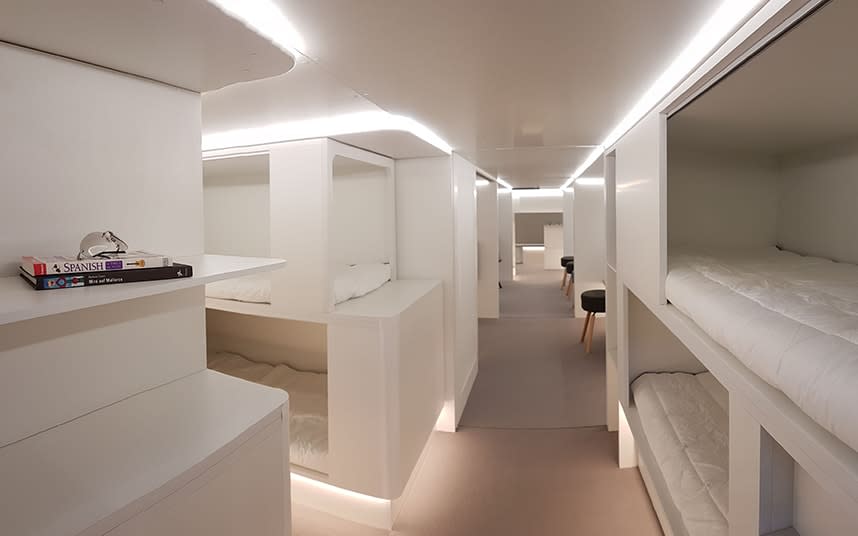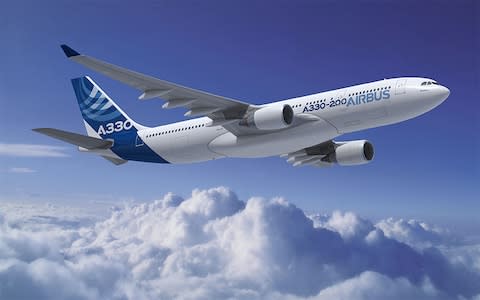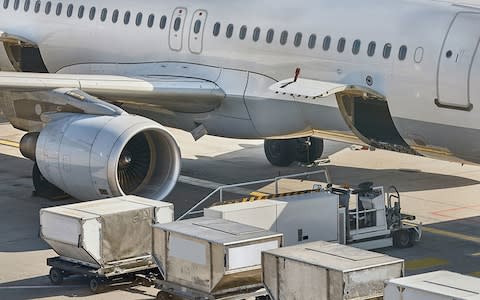Airbus wants to turn plane cargo holds into relaxation areas with beds and bars

Airbus, Europe’s biggest aircraft manufacturer, has announced plans to turn plane cargo holds into sleeping and relaxation compartments for passengers.
The firm has partnered with Zodiac Aerospace, an aviation equipment supplier, to create the concept, which could give economy class fliers the chance to swap cramped seating for capsule-style beds and sofas – or pass the time at work desks or in children’s play areas.

Passengers would not be able to access the area during take-off or landing, while the beds would be housed in removable modules that could be interchanged with ordinary cargo containers.
The designs were unveiled yesterday at the annual Aircraft Interiors Expo, held in Hamburg, along with a string of other innovations.
A mock-up of the lower level cabin showcased a minimalist decor and various types of module, including bunk beds, a play area with toys for children, and work spaces with meeting rooms and desks. Sketches also showed a standing bar area and a medical care centre.

The lower deck could also be turned into a gym or a fine-dining restaurant, Geoff Pinner, head of cabin and cargo at Airbus, suggested.
“Airlines came to us to see how they can better utilise the space in their aircraft. With lower deck use, they can also generate more revenue without having to spend money to change the aircraft or add business-class seats,” Mr Pinner told Telegraph Travel.
“On a long-haul flight, the airline could potentially rent out each of these spaces to a number of passengers in different time slots throughout the flight. So an economy class offering could potentially come with a sleeping bed add-on.”
12 hidden aircraft features you probably didn't know about
The new lower deck would fit the exact dimensions of the existing cargo space of the aircraft, leaving the structure of the plane, its cargo floor and loading system, untouched, eliminating the possibility of any rebuilding costs. The modules are designed to be easily removeable.
The innovative design is still in its early concept stages and its feasibility will need to be adapted once an airline has been secured to test the project, Mr Pinner notes.
“In terms of safety requirements, clearly the design will be built to meet all the rules outlined by the EASA [European Aviation Safety Agency] and FAA [Federal Aviation Adminstration in the US] in the normal way,” Mr Pinner said.
“We already utilise lower deck space in some other aircraft. So this would be an extension of the safety requirements met for those.”
A small scale model was unveiled in Hamburg, but a full-sized mock-up can be viewed at Airbus HQ in Toulouse.
It is hoped the concept will enter its development phase by 2020. The new design, if approved, would be rolled out across the manufacturer’s A330 aircraft for long-haul flights, with more than 150 of them already built with a basic structural provision for lower deck facilities, and potentially for the A350 aircraft in the future.

Airbus says it has been talking to “many airlines” but has yet to confirm which ones or how many are interested.
Lower deck spaces have been used for facilities including toilets on the A340 and it is also where crew rest areas are located on the A330.
Not all Zodiac Aerospace designs come to fruition, however. Back in 2015, the company filed a patent that proposed a lower cabin featuring screens that would display live footage of the outside of the plane.
Last month, Qantas CEO Alan Joyce also raised the prospect of introducing a lower deck cabin, as part of his Project Sunrise plan to create a direct flight from Sydney to both the UK and New York City.
Aircraft of the future
“In doing so, we need to re-imagine the whole travel experience,” he said in his speech at a meeting with the UK Chamber of Commerce in London.
“Is there a new class that’s needed on the aircraft? What are the out-there ideas that could apply to this and really change air travel for the future? And nothing, nothing is off the table.”
Is it safe in the cargo hold?
Bunk beds in the hold? Surely it’s freezing down there!
Actually, the hold is usually pressurised, so conditions are much the same as in the cabin – or perhaps just a shade cooler.
“Many are surprised to hear that the cargo hold in the belly of an airliner is pressurised,” Doug Morris, an Air Canada pilot, told Telegraph Travel earlier this year.

“Conditioned air is directed from the cabin, so it tends to be a little cooler by the time it reaches the cargo areas, which are also less insulated than the cabin. Cargo temperatures vary in our fleet. The Boeing 767 maintains its baggage hold above 7C, but the bulk area (where animals in transit are usually carried) can be heated above 18C. Controlled temperature cargo bins are also available when temperature-sensitive goods are being shipped.”

